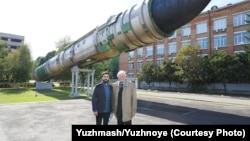DNIPRO, Ukraine -- Stanislav Yus is as polite and unassuming as the missiles he created for the Soviet Union were menacing and deadly.
When I meet Yus beside a once-dreaded but now-defunct "Satan" SS-18 intercontinental ballistic missile (ICBM) that he designed at the height of the Cold War, he's cheerful yet appears somewhat surprised to find an American on the other side of a handshake. You'd have never been allowed here 30 years ago, he chuckles.
"Here" is inside Ukraine's heavily guarded and secretive state-run rocket-making factory, comprised of the Yuzhnoye design bureau and its manufacturing partner, Yuzhmash.
Yus, 80, a native of the Dnipro region, started his career at Yuzhnoye at the age of 22 under the tutelage of then-chief designer Mikhail Yangel, a Soviet legend. He rose rapidly through the ranks, helping design several rockets and spacecraft. But his legacy is built on the massive ICBMs he designed, like the Satan, as the West called it, which could deliver 10 or more nuclear warheads with great precision halfway around the world in roughly 20 minutes.
Yus -- a laureate of the Soviet Lenin Prize, Lenin Komsomol Prize, and a Hero of Socialist Labor -- is already a legend in his own right, and one of the last of his generation of missile designers.
After a quick ride to Yangel's original home near the factory, Yus gives a detailed history of Yuzhnoye and explains how drastically things changed for the factory at the end of the Cold War and the collapse of the U.S.S.R. In a nutshell, government contracts had ensured that the factory stayed busy. The period following Ukraine's independence was a "trying" time, he says.
He appears uncomfortable, or perhaps just cautious, when discussing the relationship between Ukraine and Russia these days, more than three years into an undeclared war that has killed more than 10,100 people. He prefers to stick to talking design, the more technical the better.
But I want to know: Did he ever think about the devastation the missiles he designed during the Cold War were capable of inflicting, of nuclear annihilation?
Yus takes a deep breath.
"I wasn't overthinking it," he says, suggesting that compartmentalization is a key element for a missile designer to effectively do his job.
Pressed a bit, he admits in his characteristic manner that he remained fully aware that, had the Cold War turned hot and his missiles been let loose, it would have marked a "very destructive period for the world."
"We were working in accordance with the Soviet policies only to protect the Soviet Union in the event that we were struck first," he adds.
Today, he says, with Yuzhnoye having diversified and investment spread among other activities, "it doesn't allow us to work fully in the area of rocket complexes." Rocket design and manufacturing continues, but at a much slower pace than in Soviet times.
Much of Yus's focus now is on designing high-capacity wind turbines, trolleybuses, and combine harvesters that the company believes will help it to endure in a new age.
But given the chance, he'd get back to work full-time on designing missiles, Yus says, which are "needed for the defense of the country."





